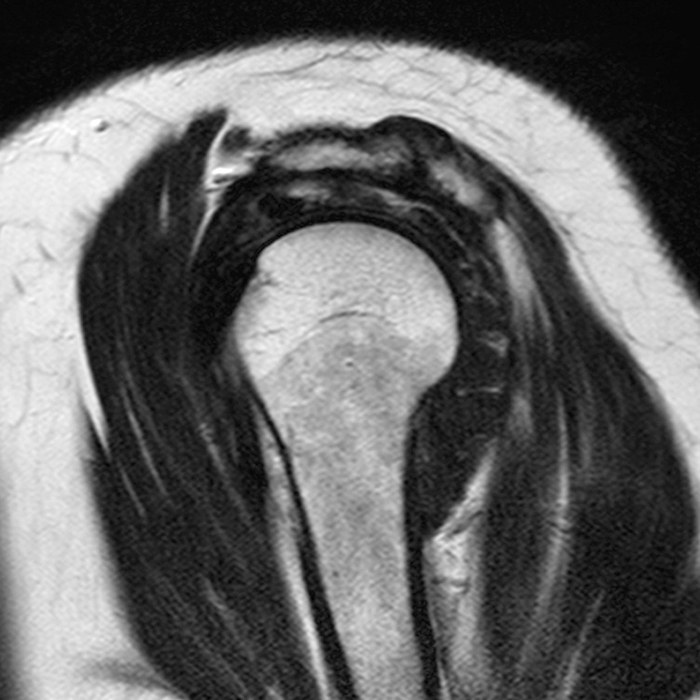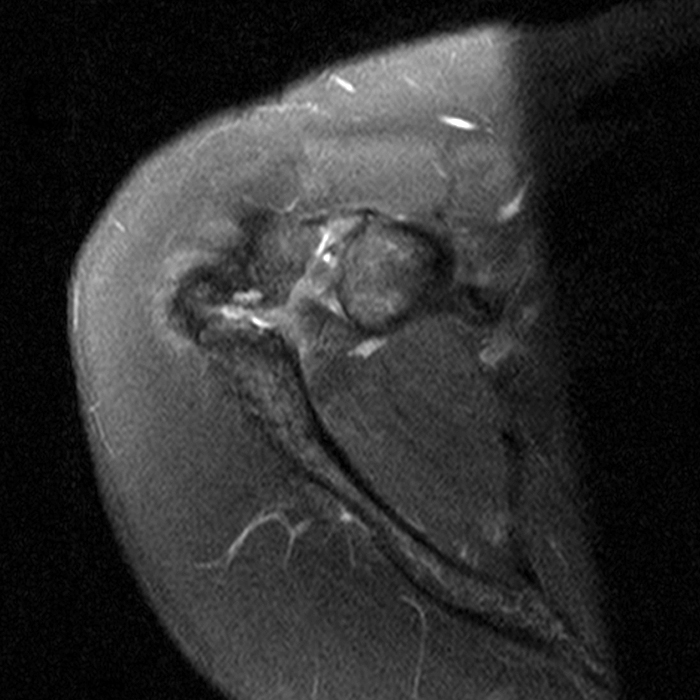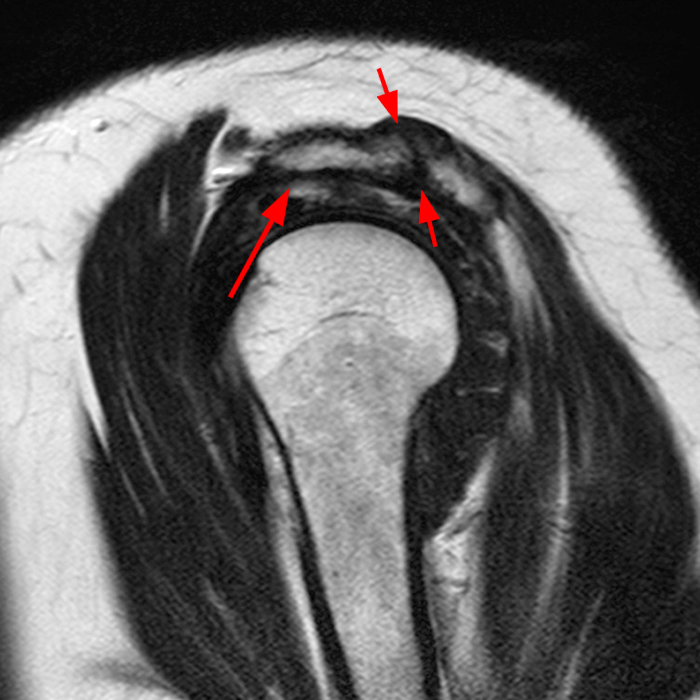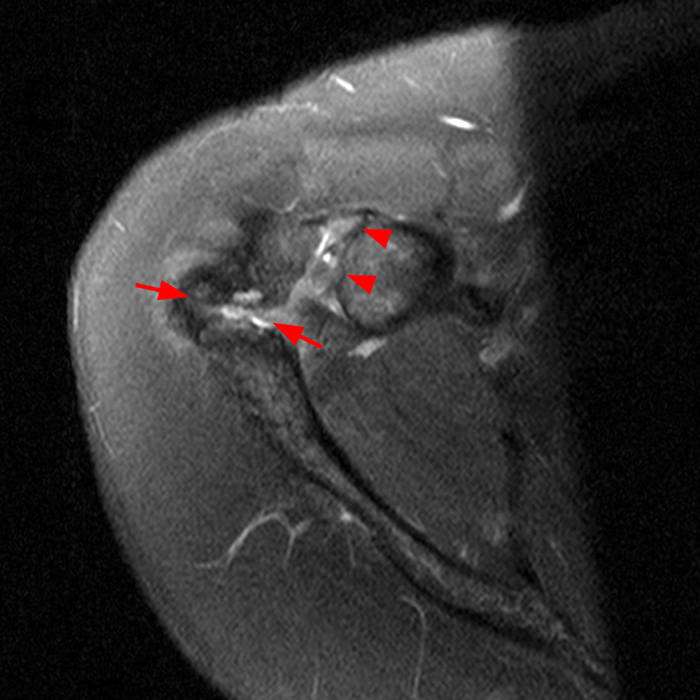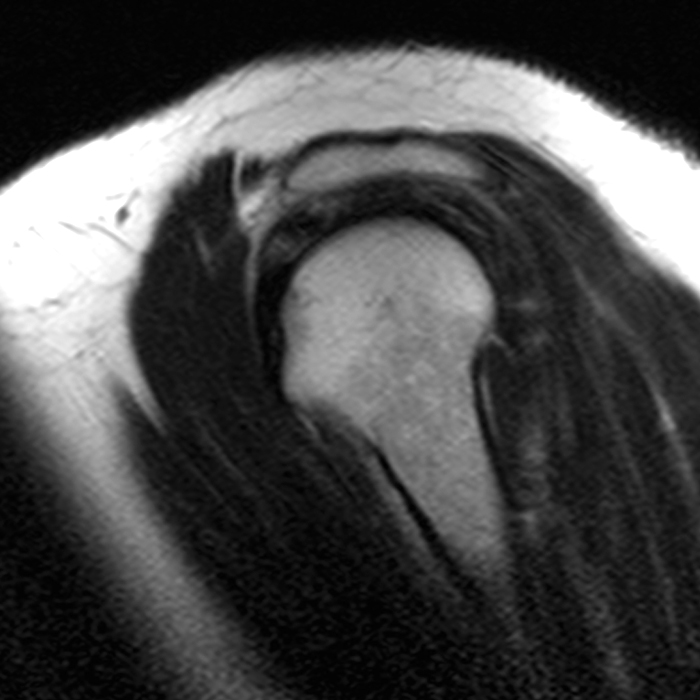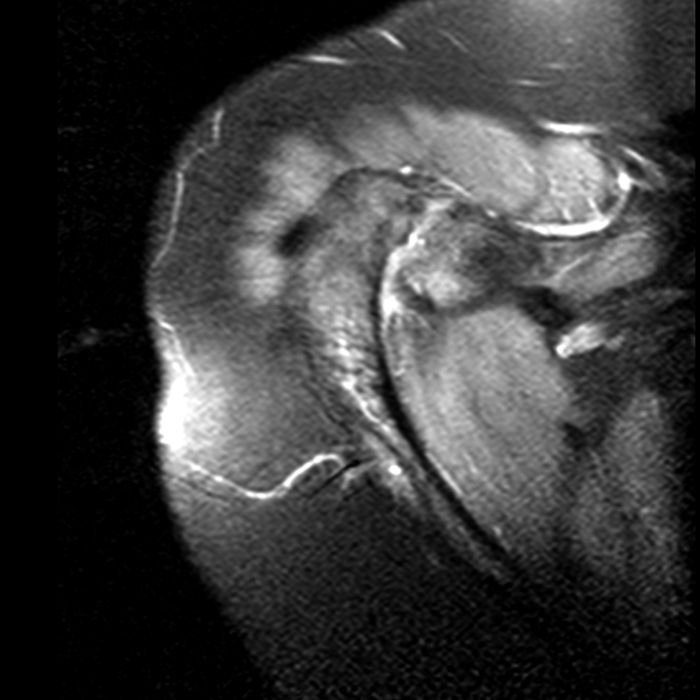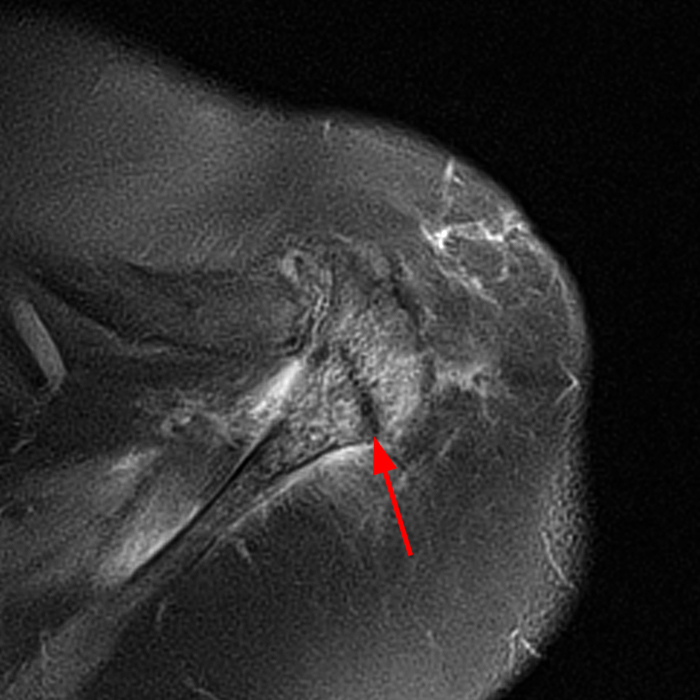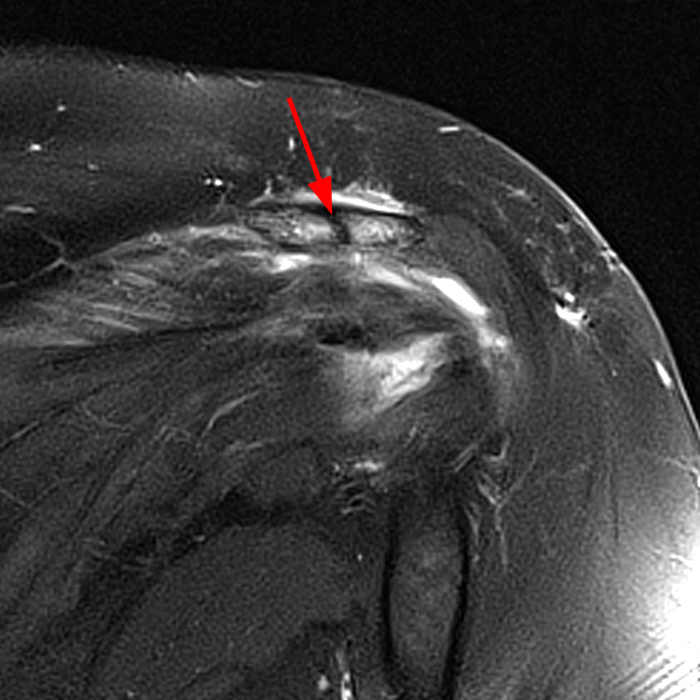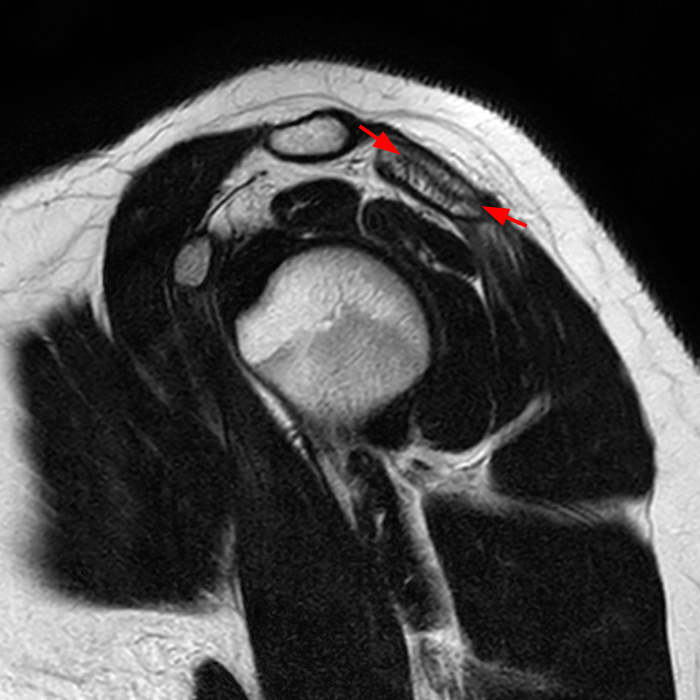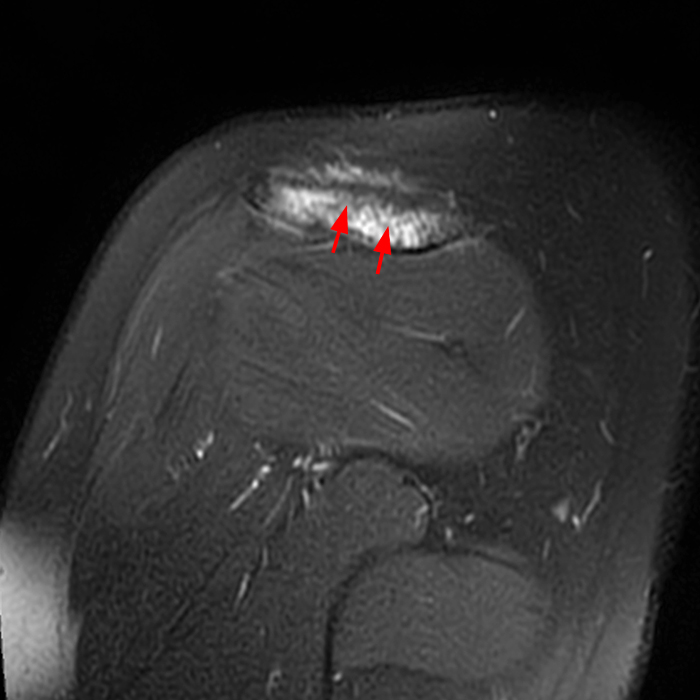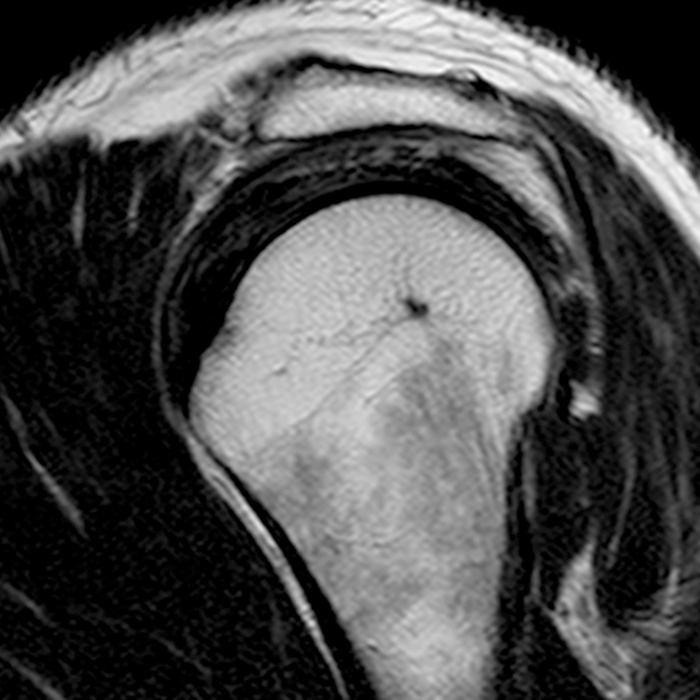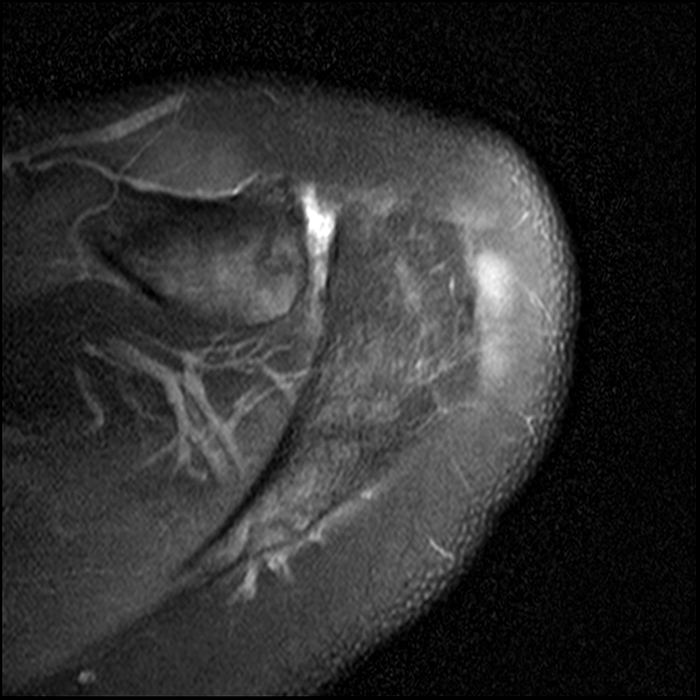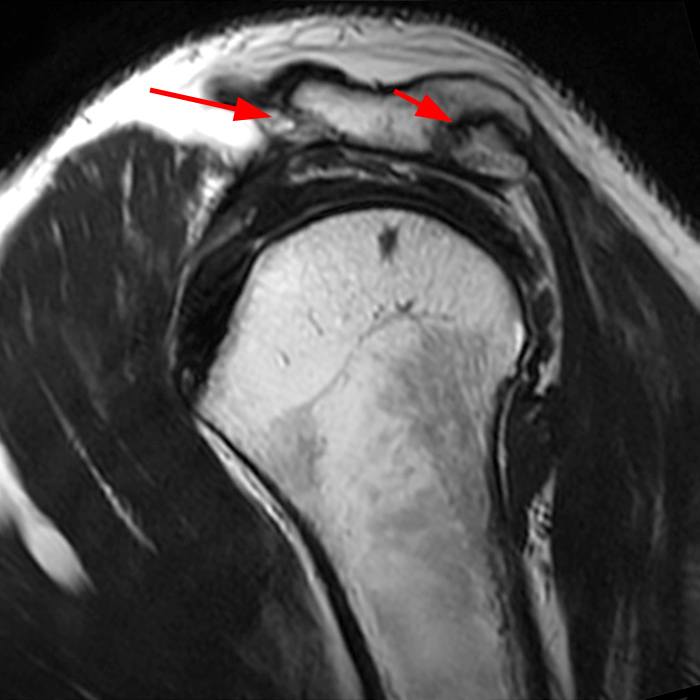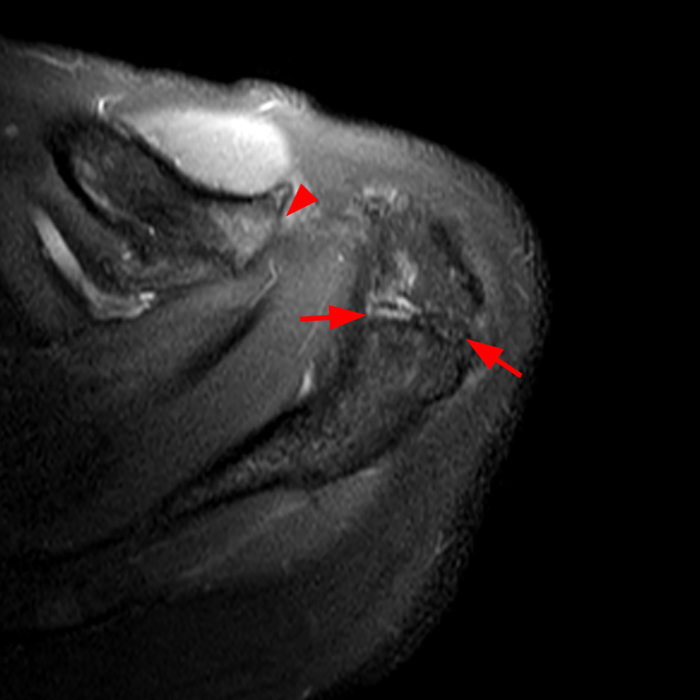Clinical History: A 56-year-old female complains of shoulder pain with a history of an acromioplasty and distal clavicular resection. A sagittal T2-weighted image (1a) and an axial fat-suppressed proton density-weighted image (1b) of the shoulder are provided. What are the findings? What is your diagnosis?
Findings
Figure 2:
The sagittal T2-weighted image (2a) demonstrates an attenuated lateral acromion status post acromioplasty (arrow) and a line of decreased signal intensity with adjacent bony remodeling (short arrows). The axial fat-suppressed proton density-weighted image (2b) demonstrates a line with mixed signal involving the lateral acromion (short arrows). A distal clavicular resection is seen (arrowheads). Comparison pre-operative images performed 8-years previously include a sagittal T2-weighted image (2c) and an axial fat suppressed-proton density-weighted image (2d) that show no evidence of an os acromiale or synchondrosis.
Diagnosis
Acromial stress fractures after shoulder decompression surgery.
Discussion
Subacromial decompression is a common procedure for the treatment of impingement syndrome. An uncommon complication of subacromial decompression is a stress fracture of the acromion. Only seven cases of post-decompression acromial stress fractures are reported in the literature and presumably these fractures are under-reported.1,2
In a series of six patients with post-decompression fractures, sudden onset of pain usually occurred during physical therapy. The diagnoses of the fractures were delayed and with radiography, 50% of the fractures were only visible on axillary views. Clinically the presentations varied from mild pain to advanced functional impairment. The authors stated that fracture risk is increased with osteopenia and “overzealous bone resection.”1 It is tempting to speculate that the acromial stress fractures are related to reduction of bone stock with the acromioplasty, but this has not been proven, and the cause may be more complex and multi-factorial.
Stress fractures of the acromion without prior shoulder surgery are uncommon.3,4,5,6 More commonly, acromial fractures occur after reverse total shoulder arthroplasty, which is a recognized complication that occurs in 1.5-5% of patients. No proven cause or predisposition for these fractures have been reported.7,8,9,10,11,12,13,14
Traumatic fractures of the acromion are uncommon and usually occur in patients with multiple fractures. Delayed diagnoses are common as is non-union of the acromial fractures.15 Acute post-traumatic fractures of the acromion can occur anywhere along the acromial process. The acute fractures have typical fracture lines with marrow edema, and unlike stress fractures, no reactive changes with bony remodeling are present (Fig. 3 and 4).
Usually an os acromiale is an incidental finding but in a minority of patients, may be unstable and a cause of pain16(Fig. 5). An unstable os acromiale with reactive osseous changes can be indistinguishable from a stress fracture or a remote non-united fracture, and differentiation may be impossible in the absence of prior imaging and clinical history.
Figure 5:
16-year-old male with trauma and pain. A sagittal T2-weighted image (5a) shows a line of decreased signal involving the acromion (arrow). An axial fat-suppressed proton density-weighted image (5b) reveals the line (arrow) with adjacent reactive osseous changes and marrow edema (asterisks). No prior imaging was available. Based on clinical information, an unstable os acromiale was favored over a stress fracture.
Imaging
MRI
Stress fractures of the acromion after decompression surgery typically occur at the expected level of the synchondrosis of the mesoacromion. The stress fractures have the typical appearances of fractures seen in other locations including fracture lines with adjacent reactive changes including cortical irregularities, osseous remodeling and marrow/soft tissue edema (Fig. 6).
Figure 6:
56- year-old male with pain. Pre-operative sagittal T2-weighted-image (6a) and an axial fat suppressed-proton density-weighted image (6b) show no abnormalities of the acromion. Post-operative images eight years later include (6c) a sagittal T2-weighted image with an attenuated lateral acromion status post acromioplasty (arrow) and a fracture line with adjacent bony remodeling (short arrow). Post-operative (6d) axial fat-suppressed proton density-weighted image demonstrates a fracture involving the lateral acromion (arrow). A distal clavicular resection is present (arrowhead).
Radiography
The radiography of stress fractures of the acromion after decompression surgery may demonstrate a fracture line and adjacent osseous reactive change. The fractures may not be detected unless an axillary view is included in the radiographic series.
Differential diagnosis
The differential diagnosis is limited to an unstable os acromiale, with reactive changes at the synchondrosis or a remote non-united traumatic fracture which are indistinguishable from a stress fracture. Correlation with clinical history and prior imaging is necessary to differentiate between an unstable os acromiale, a remote non-united traumatic fracture or a stress fracture.
Treatment and Prognosis
The treatment options for a stress fracture of the acromion after shoulder decompression include conservative therapy or surgical stabilization at the fracture site, and because of the small number of reported cases, the optimal therapy has not been determined.1, 2 Stress fractures after total reverse shoulder arthroplasty, which are more common, have also been treated with conservative therapy and surgical stabilization with mixed results.11, 13, 14, 17,18 The prognosis for post-surgical acromial stress fractures is variable and generally the patients have a worse outcome than patients without stress fractures.11, 13, 14, 17, 18
Summary
Stress fractures of the acromion after shoulder decompression are an uncommon complication of the procedure. The number of fractures is likely underreported. The acromial stress fractures are easily diagnosed with MRI by typical fracture lines and reactive osseous changes. The stress fractures after shoulder decompression are indistinguishable from unstable os acromiales and remote non-united traumatic fractures, and correlation with history and prior imaging is necessary for the correct diagnosis.
References
- Matthews LS, Burkhead WZ, Gordon S, Racanelli J, Ruland L. Acromial fracture: A complication of arthroscopic subacromial decompression. J Shoulder Elbow Surg. 1994;3(4):256-61. ↩
- Rupp S, Seil R, Kohn DM. Surgical reconstruction of a stress fracture of the acromion after arthroscopic subacromial decompression in an elite tennis player. Arthroscopy. 1998;14(1):106-8. ↩
- Kim DH, Na SS, Baek CS, Cho CH. Bilateral acromial stress fractures in a patient with a massive rotator cuff tear. Clin Shoulder Elb. 2020;23(2):105-8. ↩
- Purnell JA, Bourget-Murray J, Kwapisz A, Bois AJ, LeBlanc J. Clinical results and complications following surgical management of symptomatic os acromiale: a systematic review. J Orthop Surg Res. 2019;14(1):26. ↩
- Tagliapietra J, Fantoni I, Taglialavoro G, Angelini A, Berizzi A, Belluzzi E, et al. Symptomatic pseudoarthrosis secondary to a stress fracture of the acromion. Acta Biomed. 2019;90(4):603-5. ↩
- Dennis DA, Ferlic DC, Clayton ML. Acromial stress fractures associated with cuff-tear arthropathy. A report of three cases. J Bone Joint Surg Am. 1986;68(6):937-40. ↩
- Roche CP, Fan W, Simovitch R, Wright T, Flurin PH, Zuckerman JD, et al. Impact of Accumulating Risk Factors on the Acromial and Scapular Fracture Rate after Reverse Total Shoulder Arthroplasty with a Medialized Glenoid/Lateralized Humerus Onlay Prosthesis. J Shoulder Elbow Surg. 2023. ↩
- Yeazell ST, Inacio J, Malige A, Dailey H, Carolan GF. Bone density and its relation to the development of acromial stress fracture following reverse total shoulder arthroplasty. Shoulder Elbow. 2022;14(2):135-41. ↩
- Lau SC, Large R. Acromial fracture after reverse total shoulder arthroplasty: a systematic review. Shoulder Elbow. 2020;12(6):375-89. ↩
- Cho CH, Rhee YG, Yoo JC, Ji JH, Kim DS, Kim YS, et al. Incidence and risk factors of acromial fracture following reverse total shoulder arthroplasty. J Shoulder Elbow Surg. 2021;30(1):57-64. ↩
- Cho CH, Jung JW, Na SS, Bae KC, Lee KJ, Kim DH. Is Acromial Fracture after Reverse Total Shoulder Arthroplasty a Negligible Complication?: A Systematic Review. Clin Orthop Surg. 2019;11(4):427-35. ↩
- Zmistowski B, Gutman M, Horvath Y, Abboud JA, Williams GR, Jr., Namdari S. Acromial stress fracture following reverse total shoulder arthroplasty: incidence and predictors. J Shoulder Elbow Surg. 2020;29(4):799-806. ↩
- Patterson DC, Chi D, Parsons BO, Cagle PJ, Jr. Acromial spine fracture after reverse total shoulder arthroplasty: a systematic review. J Shoulder Elbow Surg. 2019;28(4):792-801. ↩
- Hamid N, Connor PM, Fleischli JF, D’Alessandro DF. Acromial fracture after reverse shoulder arthroplasty. Am J Orthop (Belle Mead NJ). 2011;40(7):E125-9. ↩
- Hess F, Zettl R, Welter J, Smolen D, Knoth C. The traumatic acromion fracture: review of the literature, clinical examples and proposal of a treatment algorithm. Arch Orthop Trauma Surg. 2019;139(5):651-8. ↩
- Barbier O, Block D, Dezaly C, Sirveaux F, Mole D. Os acromiale, a cause of shoulder pain, not to be overlooked. Orthop Traumatol Surg Res. 2013;99(4):465-72. ↩
- Galvin JW, Eichinger JK, Li X, Parada SA. Scapular Fractures After Reverse Shoulder Arthroplasty. J Am Acad Orthop Surg. 2022;30(5):e517-e27. ↩
- Kriechling P, Hodel S, Paszicsnyek A, Schwihla I, Borbas P, Wieser K. Incidence, radiographic predictors, and clinical outcome of acromial stress reaction and acromial fractures in reverse total shoulder arthroplasty. J Shoulder Elbow Surg. 2022;31(6):1143-53. ↩

